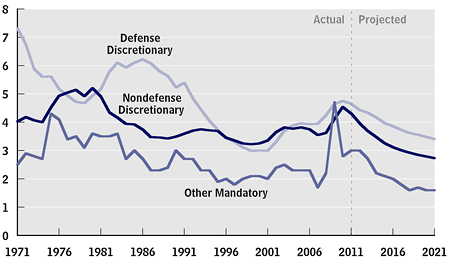As policymakers consider the composition of policy changes to be used to reduce future budget deficits, it is useful to consider both historical experience and projections for the future for significant components of the budget. Today, I’ll discuss federal spending for programs and activities other than Social Security and the government’s major health care programs.
Such spending (apart from that for interest payments on the government’s debt) has averaged 11.5 percent of GDP during the past 40 years and equals 12.0 percent in 2011. That broad category includes some mandatory spending as well as all of defense and nondefense discretionary spending. That mandatory spending includes various income security programs, retirement benefits, and other outlays. Defense spending is by far the largest single piece of the broad category, and nondefense discretionary spending includes transportation, health research, education and training, and other programs. Given the assumptions that govern CBO’s baseline projections, spending for all of these programs together is projected to equal 7.7 percent of GDP in 2021, the lowest as a share of GDP in the past 40 years.
The mandatory spending in that category is spending apart from that on Social Security and the major health care programs—specifically, outlays for the Supplemental Nutrition Assistance Program (formerly known as Food Stamps), unemployment compensation, some veterans’ benefits, federal civilian and military retirement benefits, and other programs (including offsetting receipts). Such spending averaged 2.7 percent of GDP during the past 40 years and totals 3.0 percent in 2011. Expected improvement in the economy and other factors reduces that spending to 1.6 percent of GDP by 2021 in CBO’s baseline projections (see the figure below).
| Other Federal Spending, by Category (Percent of GDP) |
 |
Discretionary spending, which stood at 11.3 percent of GDP in 1971, will total 9.0 percent in 2011. As a result of the caps put in place by the Budget Control Act (and apart from any further reduction in caps triggered by the enforcement provisions of the act), such spending will fall sharply relative to the size of the economy over the next 10 years, reaching 6.1 percent in 2021, CBO projects. That reduction in discretionary spending could be achieved by many different combinations of defense and nondefense appropriations. For example, if defense and nondefense appropriations (excluding war-related funding) were reduced proportionately, relative to the funding that would be necessary to keep pace with inflation, defense spending would total 3.4 percent of GDP in 2021 while nondefense spending would equal 2.7 percent, CBO estimates. By comparison, in 1971, defense and nondefense spending totaled 7.3 percent and 4.0 percent of GDP. Many other combinations of defense and non-defense funding are possible under the caps.

